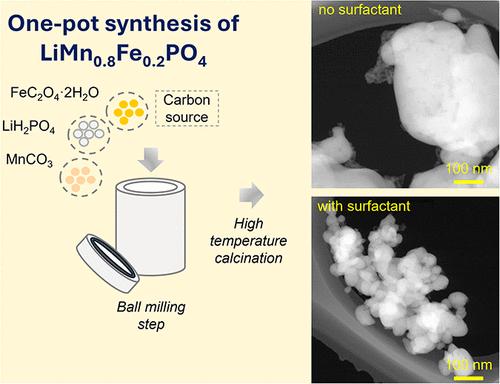Impact of Synthesis Conditions and Carbon Source on the Voltage Polarization Growth of Lithium Manganese Iron Phosphate
IF 7
2区 材料科学
Q2 CHEMISTRY, PHYSICAL
引用次数: 0
Abstract
A high-performance LiMn0.8Fe0.2PO4 (LMFP82)-positive electrode material is prepared using a simple surfactant-assisted synthesis method. Polyvinylpyrrolidone (PVP) is used as a surfactant and carbon source that leads to a thin and uniform carbon coating on the surface of nanosized LMPF82 primary particles. The synthesis parameters were varied systematically to clarify the effects of carbon content and calcination temperature on the electrochemical performance of these LMFP82 materials. The best performing LMFP82 sample, made with 20 wt % initial PVP content and calcined at 700 °C, showed a high initial discharge capacity of 155 mAh g–1 at 0.05C to 4.2 V, impressive rate performance with 142 mAh g–1 at 5C and 30 °C, high cycling stability with no capacity fade after 100 cycles at 0.2C, and low voltage polarization that remains stable over cycling. This study shows that the amount of carbon precursor impacts the specific capacity but not the voltage polarization growth, when within reasonable bounds (10–30 wt %). The calcination temperature on the other hand affects both specific capacity and voltage polarization growth and needed to be carefully optimized to 700 °C for optimal performance.

合成条件和碳源对磷酸锰铁锂电压极化生长的影响
采用简单的表面活性剂辅助合成方法制备了高性能LiMn0.8Fe0.2PO4 (LMFP82)正极材料。聚乙烯吡咯烷酮(PVP)作为表面活性剂和碳源,在纳米级LMPF82初级颗粒表面形成了一层薄而均匀的碳涂层。系统地改变了合成参数,以阐明碳含量和煅烧温度对LMFP82材料电化学性能的影响。性能最好的LMFP82样品,在初始PVP含量为20 wt %,在700°C下煅烧,在0.05C至4.2 V下具有155 mAh g-1的高初始放电容量,在5C和30°C下具有142 mAh g-1的令人印象深刻的倍率性能,高循环稳定性,在0.2C下循环100次后没有容量衰减,并且在循环过程中保持稳定的低电压极化。本研究表明,在合理的范围内(10-30 wt %),碳前驱体的用量对比容量有影响,但对电压极化生长没有影响。另一方面,煅烧温度影响比容量和电压极化生长,需要仔细优化到700°C以获得最佳性能。
本文章由计算机程序翻译,如有差异,请以英文原文为准。
求助全文
约1分钟内获得全文
求助全文
来源期刊

Chemistry of Materials
工程技术-材料科学:综合
CiteScore
14.10
自引率
5.80%
发文量
929
审稿时长
1.5 months
期刊介绍:
The journal Chemistry of Materials focuses on publishing original research at the intersection of materials science and chemistry. The studies published in the journal involve chemistry as a prominent component and explore topics such as the design, synthesis, characterization, processing, understanding, and application of functional or potentially functional materials. The journal covers various areas of interest, including inorganic and organic solid-state chemistry, nanomaterials, biomaterials, thin films and polymers, and composite/hybrid materials. The journal particularly seeks papers that highlight the creation or development of innovative materials with novel optical, electrical, magnetic, catalytic, or mechanical properties. It is essential that manuscripts on these topics have a primary focus on the chemistry of materials and represent a significant advancement compared to prior research. Before external reviews are sought, submitted manuscripts undergo a review process by a minimum of two editors to ensure their appropriateness for the journal and the presence of sufficient evidence of a significant advance that will be of broad interest to the materials chemistry community.
 求助内容:
求助内容: 应助结果提醒方式:
应助结果提醒方式:


